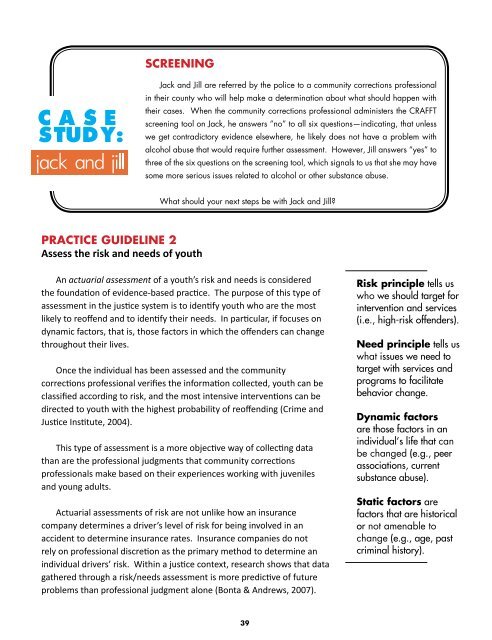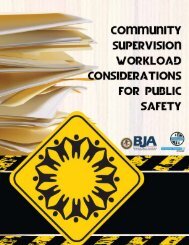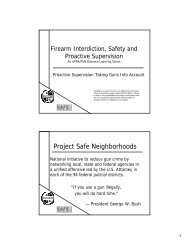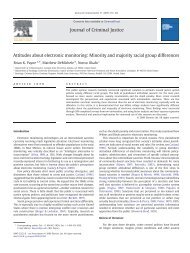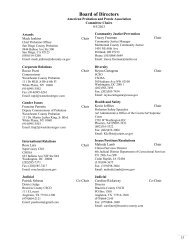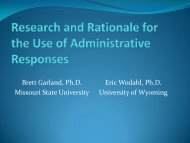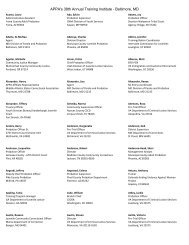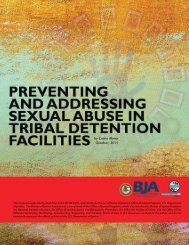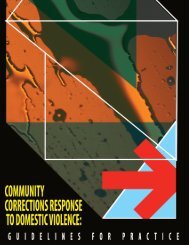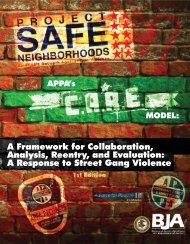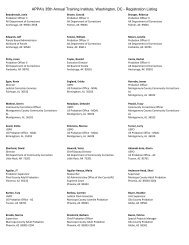Intervention Principles and Practice Guidelines for - Underage ...
Intervention Principles and Practice Guidelines for - Underage ...
Intervention Principles and Practice Guidelines for - Underage ...
Create successful ePaper yourself
Turn your PDF publications into a flip-book with our unique Google optimized e-Paper software.
Screening<br />
Jack <strong>and</strong> Jill are referred by the police to a community corrections professional<br />
in their county who will help make a determination about what should happen with<br />
their cases. When the community corrections professional administers the CRAFFT<br />
screening tool on Jack, he answers “no” to all six questions—indicating, that unless<br />
we get contradictory evidence elsewhere, he likely does not have a problem with<br />
alcohol abuse that would require further assessment. However, Jill answers “yes” to<br />
three of the six questions on the screening tool, which signals to us that she may have<br />
some more serious issues related to alcohol or other substance abuse.<br />
What should your next steps be with Jack <strong>and</strong> Jill?<br />
<strong>Practice</strong> Guideline 2<br />
Assess the risk <strong>and</strong> needs of youth<br />
An actuarial assessment of a youth’s risk <strong>and</strong> needs is considered<br />
the foundation of evidence-based practice. The purpose of this type of<br />
assessment in the justice system is to identify youth who are the most<br />
likely to reoffend <strong>and</strong> to identify their needs. In particular, if focuses on<br />
dynamic factors, that is, those factors in which the offenders can change<br />
throughout their lives.<br />
Once the individual has been assessed <strong>and</strong> the community<br />
corrections professional verifies the in<strong>for</strong>mation collected, youth can be<br />
classified according to risk, <strong>and</strong> the most intensive interventions can be<br />
directed to youth with the highest probability of reoffending (Crime <strong>and</strong><br />
Justice Institute, 2004).<br />
This type of assessment is a more objective way of collecting data<br />
than are the professional judgments that community corrections<br />
professionals make based on their experiences working with juveniles<br />
<strong>and</strong> young adults.<br />
Actuarial assessments of risk are not unlike how an insurance<br />
company determines a driver’s level of risk <strong>for</strong> being involved in an<br />
accident to determine insurance rates. Insurance companies do not<br />
rely on professional discretion as the primary method to determine an<br />
individual drivers’ risk. Within a justice context, research shows that data<br />
gathered through a risk/needs assessment is more predictive of future<br />
problems than professional judgment alone (Bonta & Andrews, 2007).<br />
Risk principle tells us<br />
who we should target <strong>for</strong><br />
intervention <strong>and</strong> services<br />
(i.e., high-risk offenders).<br />
Need principle tells us<br />
what issues we need to<br />
target with services <strong>and</strong><br />
programs to facilitate<br />
behavior change.<br />
Dynamic factors<br />
are those factors in an<br />
individual’s life that can<br />
be changed (e.g., peer<br />
associations, current<br />
substance abuse).<br />
Static factors are<br />
factors that are historical<br />
or not amenable to<br />
change (e.g., age, past<br />
criminal history).<br />
39


